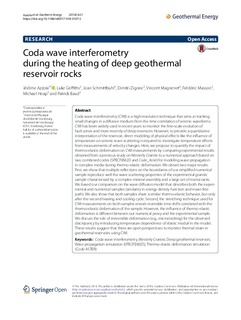| dc.description.abstract | Coda wave interferometry (CWI) is a high-resolution technique that aims at tracking small changes in a diffusive medium from the time correlation of seismic waveforms. CWI has been widely used in recent years to monitor the fine-scale evolution of fault zones and more recently of deep reservoirs. However, to provide a quantitative interpretation of the reservoir, direct modeling of physical effects like the influence of temperature on seismic wave scattering is required to investigate temperature effects from measurements of velocity changes. Here, we propose to quantify the impact of thermo-elastic deformation on CWI measurements by comparing experimental results obtained from a previous study on Westerly Granite to a numerical approach based on two combined codes (SPECFEM2D and Code_Aster) for modeling wave propagation in complex media during thermo-elastic deformation. We obtain two major results. First, we show that multiple reflections on the boundaries of our simplified numerical sample reproduce well the wave scattering properties of the experimental granitic sample characterized by a complex mineral assembly and a large set of microcracks. We based our comparison on the wave diffusion model that describes both the experimental and numerical samples (similarity in energy density function and mean free path). We also show that both samples share a similar thermo-elastic behavior, but only after the second heating and cooling cycle. Second, the stretching technique used for CWI measurements on both samples reveals reversible time shifts correlated with the thermo-elastic deformation of the sample. However, the influence of thermo-elastic deformation is different between our numerical proxy and the experimental sample. We discuss the role of irreversible deformation (e.g., microcracking) for the observed discrepancy by introducing temperature dependence of elastic moduli in the model. These results suggest that there are open perspectives to monitor thermal strain in geothermal reservoirs using CWI. | |
